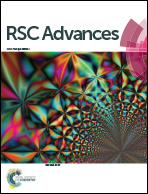Electrochemical energy storage and adsorptive dye removal of Platanus fruit-derived porous carbon†
Abstract
Activated Platanus fruit carbon (a-PFC) was synthesized by pyrolytic carbonization and alkali activation treatment of an easily available biomass, Platanus fruit (PF). Carbonization yielded a Platanus fruit carbon (PFC) sample with a partially graphitized phase, and the following KOH activation created a highly porous texture containing a large fraction of micropores, and therefore a high specific surface area. Both of these factors are beneficial for surface-related applications such as electrode materials for electrochemical capacitors and adsorbents for the removal of organic dyes. A supercapacitor based on a-PFC3, which was synthesized with a KOH : PFC activation ratio of 3, offers a high gravimetric capacitance of 216 F g−1 at 1 A g−1, a high rate performance and an excellent cycling stability, highlighting the potential of a-PFC3 in electrochemical energy storage. Its high specific surface area also makes a-PFC3 an efficient adsorbent for the removal of methylene blue (MB) from aqueous solution.


 Please wait while we load your content...
Please wait while we load your content...